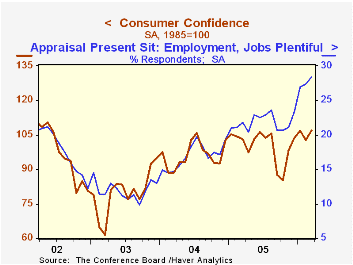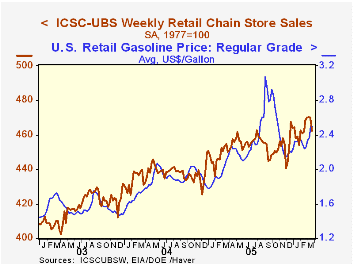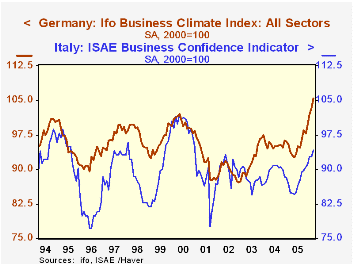 Global| Mar 28 2006
Global| Mar 28 2006Consumer Confidence Up Sharply
by:Tom Moeller
|in:Economy in Brief
Summary
The Conference Board's Index of Consumer Confidence jumped 4.4% during March to 107.2, the highest level in nearly four years. The jump compared to Consensus expectations for stability at 102.0 and the m/m stability in the University [...]

The Conference Board's Index of Consumer Confidence jumped 4.4% during March to 107.2, the highest level in nearly four years. The jump compared to Consensus expectations for stability at 102.0 and the m/m stability in the University of Michigan's March Index of Consumer Sentiment.
During the last twenty years there has been a 52% correlation between the level of consumer confidence and the y/y change in real consumer spending. The correlation rose to 66% during the last ten years.
The index of consumers' expectations recovered most of the prior month's decline with a sharp 6.8% (-4.1% y/y) gain. Expectations for business conditions improved for the first month in four and more jobs were expected for the first month in three. Expectations for stock prices surged.
Consumers' assessment of the present situation rose for the fifth straight month. The 2.3% increase (13.9% y/y) was driven by a rise in the percentage of respondents who viewed jobs as plentiful to 28.4%, the highest since 2001. Business conditions were thought to be good by 28.3% of respondents, the highest since last July.
Price inflation expected in twelve months fell to 4.8%, down slightly from the 5.2% expected in December and down sharply from the 6.8% expected last September.
The Conference Board’s survey isconducted by a mailed questionnaire to 5,000 households and about 3,500 typically respond.
| Conference Board | Mar | Feb | Y/Y | 2005 | 2004 | 2003 |
|---|---|---|---|---|---|---|
| Consumer Confidence | 107.2 | 102.7 | 4.1% | 100.3 | 96.1 | 79.8 |
by Tom Moeller March 28, 2006

Chain store sales slid 1.6% last week, according to the International Council of Shopping Centers (ICSC)-UBS survey.The w/w drop followed a 0.1% decline during the prior period and rounded a lackluster March when sales ended the month about 1.4% lower than at the start.
The average level of sales in March nevertheless rose roughly 1.0% versus the prior month due to a strong gain at the end of February.
During the last ten years there has been a 47% correlation between the y/y change in chain store sales and the change in nonauto retail sales less gasoline.
The leading indicator of chain store sales ticked up 0.2% after the prior week's 0.3% decline and in March is up 0.1% versus February.The ICSC-UBS retail chain-store sales index is constructed using the same-store sales (stores open for one year) reported by 78 stores of seven retailers: Dayton Hudson, Federated, Kmart, May, J.C. Penney, Sears and Wal-Mart.
Higher gasoline prices during March certainly did little to aid chain stores. Last week, the average retail price for regular gasoline held steady w/w at $2.50 per gallon (+16.0% y/y) but that followed a fourteen cent w/w jump the prior period and a fifteen cent rise in the monthly average versus February. During March, gasoline prices were at their highest since last October.
In spot market trading, yesterday's price for regular unleaded gasoline of $1.82 per gallon was up four cents from last week's average. U.S. demand for gasoline rose 1.2% from the February average (+0.3% y/y) during the latest four weeks though the very latest figures showed a decline w/w.
| ICSC-UBS (SA, 1977=100) | 03/25/06 | 03/18/06 | Y/Y | 2005 | 2004 | 2003 |
|---|---|---|---|---|---|---|
| Total Weekly Chain Store Sales | 462.4 | 470.0 | 2.7% | 3.6% | 4.7% | 2.9% |
by Tom Moeller March 28, 2006

The Federal Open Market Committee increased the target interest rate for Federal funds 25 basis points to 4.75% at today's meeting. It was the fifteenth increase since June of 2004 and the unanimous decision was widely expected by analysts.
The discount rate also was raised 25 basis points to 5.75%.
Reflecting little worry about the economic expansion, the Fed statement indicated "The slowing of the growth of real GDP in the fourth quarter of 2005 seems largely to have reflected temporary or special factors."
Future rate increases were suggested by the FOMC statement. "The Committee judges that some further policy firming may be needed to keep the risks to the attainment of both sustainable economic growth and price stability roughly in balance."
For the complete text of the Fed's latest press release please click here.
Goodbye to M3 from the Federal Reserve Bank of St. Louis can be found here.
What is Tight Money? from the American Enterprise Institute is available here.
Business Confidence Improves in Germany and Italy; Is Unchanged in Franceby Louise Curley March 28, 2006

March surveys indicate that business confidence is surprisingly strong in Germany and Italy, but subdued in France. The first chart shows the IFO business climate index for Germany and the ISAE business confidence indicator for Italy. The second chart shows the percent balance between those in the manufacturing industry, who believe conditions are improving and those who believe they are worsening for Germany and France.
Protests over a new law that makes it easier to fire young workers may have dampened French business confidence--it has shown little improvement since October of last year. However, in Germany, a strike by municipal workers against a proposal to increase the work week to 40 hours from 38.5 hours with no increase in pay has been in progress since February 6, with little or no effect on confidence.
On the contrary, Germany's IFO Business Climate Index (2000=100) rose 1.9% in March surprising most observers. The consensus had been for a slight decline. The index is now at 105.4, its highest level since April, 1991. The Business Situation or Current Conditions Index at 105.1 is also at a level last reached in November, 1991 and the Expectations Index is at its highest level since October 94. The third chart shows the history of the Business Situation and Expectations Indexes since their inception in January, 1991.
Although Italy's ISAE measure of business confidence rose in March--1.6%--to reach 94.2 (2000=100), the highest level since January, 2000, the level of confidence remains almost 6% below that of 2000 while the level in Germany is now some 5% above the 2000 average level.
| Business Confidence | Mar 06 | Feb 05 | Mar 05 | M/M % or Pct chg | Y/Y % or Pct chg | 2005 | 2004 | 2003 |
|---|---|---|---|---|---|---|---|---|
| Germany: IFO (2000=100) | ||||||||
| Business Climate | 105.4 | 103.3 | 93.9 | 1.93 | 12.37 | 95.5 | 95.4 | 91.3 |
| Current Situation | 105.1 | 101.9 | 92.3 | 3.14 | 13.87 | 94.7 | 93.1 | 88.1 |
| Expectations | 105.7 | 104.9 | 95.2 | 0.76 | 11.03 | 96.3 | 97.8 | 95.6 |
| Italy: ISAE (2000=100) | 94.2 | 92.7 | 84.9 | 1.62 | 10.95 | 87.5 | 89.5 | 88.0 |
| France: General Outlook Manufacturing % Balance | -2.0 | -2.0 | -5.0 | 0.0 | 3.0 | -12 | 5 | -29 |
| Germany: Business Climate in Mfg % Balance | 19.2 | 14.9 | -1.5 | 4.3 | 20.7 | 1.1 | 4.4 | -8.0 |
Tom Moeller
AuthorMore in Author Profile »Prior to joining Haver Analytics in 2000, Mr. Moeller worked as the Economist at Chancellor Capital Management from 1985 to 1999. There, he developed comprehensive economic forecasts and interpreted economic data for equity and fixed income portfolio managers. Also at Chancellor, Mr. Moeller worked as an equity analyst and was responsible for researching and rating companies in the economically sensitive automobile and housing industries for investment in Chancellor’s equity portfolio. Prior to joining Chancellor, Mr. Moeller was an Economist at Citibank from 1979 to 1984. He also analyzed pricing behavior in the metals industry for the Council on Wage and Price Stability in Washington, D.C. In 1999, Mr. Moeller received the award for most accurate forecast from the Forecasters' Club of New York. From 1990 to 1992 he was President of the New York Association for Business Economists. Mr. Moeller earned an M.B.A. in Finance from Fordham University, where he graduated in 1987. He holds a Bachelor of Arts in Economics from George Washington University.






